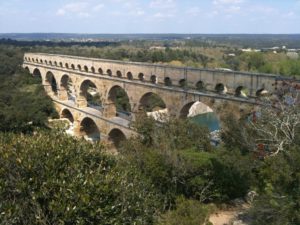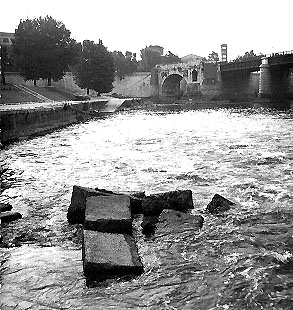Roman Builders
Building A Road
When the Romans built roads they used great accuracy. When they made roads they made sure that it was pointing in the right direction so that it was as straight as possible. They did that by using two sticks which had weights hanging from each side. The person making sure that it was straight they aligned the weights so that they could not see the others as it was covered by the others. This meant that it was straight. after that to make a road they built a road they dug a hole that was 1 meter deep. They then put large stones and then smaller stones. They then put a layer of pebbles and then sand to make it smooth. When they had finished they put stone slabs that were flat and the right size. When they got to a river they took some boats and attached them together. When this was finished they built the next bridge in that area. To build the bridge they pushed wooden logs to keep the water out while they built it. they blocked the holes with silt that stuck. When they had done that they pumped the water out. When they had done that they started to put a layer of bitumen and then stones and they continued until it was the right height. When they have done that they put the road on the foundations. When they make the road they then make the middle higher so that when there is rain water it gets drained to the side.
Building an aqueduct

An aqueduct is a channel built by man to bring water from one place to the other. They used it to bring water from a stream to a bath house or other buildings. They had to make sure that everything was straight. To do this they used levelling equipment to make it level so that it flows to the destination. This was hard because they needed to make special equipment to be able to do that. The equipment they used was chorobats. To use these instruments you made sure that the water in the middle was straight and level. They measure the distance from the ground level to the imaginary level that the aqueduct was supposed to be at. They did this at every 1 meter 20 centimetres. They made sure that it was to high for people to poison or steal some of the water. To support the weight of the pillars they had to make some big foundations so that it would not sink. They used cement and stones to do it with. When they got to a hill they drilled through it. they build a shaft every 20 meters and when they did that they measured the height to make sure that it was at the right level. While they dug through the hills they placed the stones while they were making it.
When it arrived to the city the aqueduct went into a water tank. Every water tank was covered by a cement vault. They then made some wood supports which were curved. They then placed bricks in an arc. When they did that they put cement to make it solid. When this was done and it held the roof they then removed the wood supports. They then put pipes so that the water could be taken to where they wanted it. They then covered the roof of the container with tiles and sloping roof so that it looked nicer.
The builder's tools

The Romans used the same type of tools as the workers use now. When they wanted to pull heavy weights up they used something similar to a crane but it was in wood and powered by a man walking in a wheel to make the objects go up. When they built things they used the same tools but they also had a levelling table and things like that to make sure the aqueduct or the roads. The tools still have not been changed.